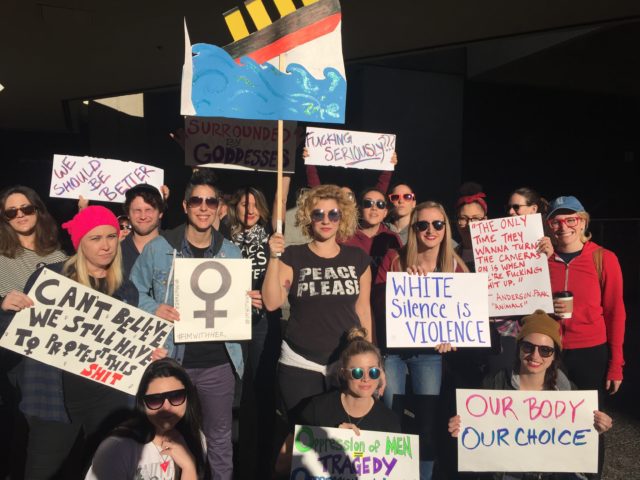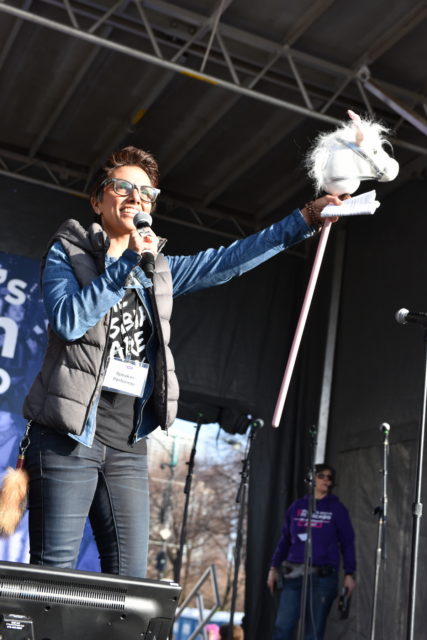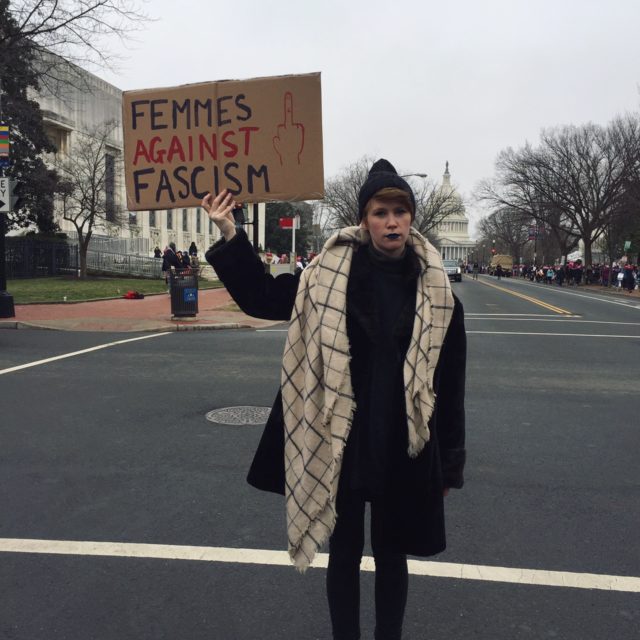
“I’ve been to many demonstrations—Prop. 8 protests, Hillary Clinton rallies, protests after Trump was elected—but being a part of the Women’s March in Los Angeles (750,000 strong!) was incredible in a way that I couldn’t even anticipate. Turning down the hill toward where marchers were gathered, there were women for what felt like miles—no end point, like downtown L.A., was full up. But it wasn’t just the sheer number of participants—it was the energy. It was the mass amount of strength radiating from women and children and our allies—husbands, friends, boyfriends, gay men. And the ones that came knew it wasn’t about them. Donald Trump is a direct assault on women, and in so many ways that the signs, the chants, the conversations were so varied and so specific that the storytelling was one of the most vital parts of the day. How is this man—the new President of the United States—affecting you? Your health? Your self-esteem? Your family? Your worth? How are we going to be changed? How are we already?
I went to the March with 14 friends—one had a sinking Titanic for a sign reading “Women and children and LGBTQs and immigrants first.” She held it up high so we could follow her through the crowd. It was so dense, thick with marchers who couldn’t go anywhere because there were so many of us. I was surrounded by young children, teen girls, an elderly butch couple, radical anarchists, trans women—even women who might not consider themselves feminists but are ultimately a part of the rallying cry. We were all there, and that was something I can truly say I’ve never felt more optimistic about.”

Women’s March on Chicago with Fawzia Mirza (writer/actor/producer):
“I was asked to emcee the Women’s March on Chicago by Tracy Baim, founder and editor of The Windy City Times. She was working closely with the organizers and co-chairs of the Chicago march, Liz, Ann and Jessica. I said, yes, of course, I’d love to emcee. Anytime Tracy asks me to do something I say yes; she’s been a champion of mine since before I had anything to champion.
At the time, there were about 11,000 Facebook RSVPs and then lots of maybes.The week before the march, the number started rising. It hit 22,000 on the page, but then as we know, that number only represents the people who use facebook or RSVP to things.The Thursday before the march, the numbers started rising to about 40-50k, so the city shifted the location of the rally before the march. This was a good thing. This meant people were coming.
The morning of the Women’s March on Chicago, I got to Colombus and Monroe Ave, downtown Chicago at 7:30 am. At that time, the number of expected attendees was around 75,000. It was still damp and chilly. But I was excited. As a Pakistani, Muslim, queer, cisgender woman, as a Chicagoan, as an activist, as a human, it was a beautiful thing to be on stage representing intersectionality and Chicago and women. I think a challenge we have faced is that as a marginalized queer community, we often look inwards and forget about our community members who face extra challenges and struggles bc of their multiplicity of identity.
Standing on that stage, calling up each performer and speaker, seeing the actual diversity of each person, seeing the actual diversity of the crowd, I felt proud. I felt proud to be on stage, I felt proud to be a Chicagoan. I felt proud of my Americanness. That sea of bodies and signs and power was breathtaking. This struggle is not new for many members of our community. But collectively we are coming together now to face the challenges ahead. So let’s not let that energy die. We have to take action. Support the organizations who spoke at your rally or march. Volunteer with time, resources, energy. A big election is coming up in 2018, run for office, volunteer for someone who is, locally and nationally.
I very intentionally wore “The Lesbians Are Coming,” a T-shirt by local artist Jennifer Raqs. I also brought my trusted stead: a unicorn pony. And every once in a while I’d jump on the unicorn pony and ride around and yell “The Lesbians Are Coming! The Lesbians Are Coming!””
Women’s March on Woodstock, NY with Jane Demuth:
“I marched in Woodstock, NY on Saturday. Woodstock has a reputation for lefty politics, and the streets were packed. In a town of less than 6,000 residents, a thousand were marching. I marched with my dear friends and their wonderful kids; we carried signs that said “Girl Power,” and some of us wore pink hats. Unfortunately, the march began on a sour note for me, when another friend misgendered me in conversation. She apologized genuinely and profusely when I corrected her, and I let it go as well as I could. It’s a constant frustration for those of us who have transitioned in place. Even in heavily blue territory, even amongst those who wish to be allies, pronouns and names often remain a struggle. My own struggle has been how to address slips with grace, and not let them cast a shadow over my day. Any trans or genderqueer person you meet can tell you what tremendous, subtle power pronouns have.
After the march, over bowls of bibimbab and udon, I talked to another friend, someone I’ve know for over a year, about my transition. It was the first time I’d said anything to her about being trans, and although she let on that she knew, she had never slipped with pronouns or fumbled with inappropriate questions or comments. Within the community of marchers and protesters, within an earnestness to work towards doing better than we’ve done, there is a range in how well we’re hitting the mark in showing respect for each other.”

“Marching alongside around a millon people in the D.C. Women’s March was truly empowering. I personally had the goal of talking to as many trangers next to me at the march as possible. I wanted to learn what people’s plans were for taking action after the march, to keep momentum and resistance going. A lot of first-time protesters were there, and I’m glad they showed up. I hope they continue to show up. We collectively used our power to shut down the Nations Capitol on Trump’s first day in office. Everywhere you looked there was a sea of people; from the White House all the way to RFK Stadium. The only Trump supporters I saw all day were a group of 5 white men in their red “Make America Great Again” hats. They were overwhelmed by pink pussy hats and angry women.
However, it’s telling that people show up in these numbers for ciswomen. It’s awesome that so many people are getting involved and that these conversations are happening. However, a resounding question kept nagging at me throughout the march: where have these people been for the past several decades of activists fighting for social justice? Trans women, queer folks, black women, and other WOC have been on the front lines of activist movements for decades now. We have to constantly remember that is was Black queer women who started Black Lives Matter in response to racialized police brutality. The Stonewall riot was led by trans women, namely Sylvia Rivera. Her story is often erased from that history, just like the incredible work of the most marginalized people is often erased from mainstream history. Yes, the Women’s March was a historical event not be forgotten.
We must educate the masses that it was, in fact, built on (at the risk of erasing or overshadowing) a long history of engagement and activism by trans women, queer folks, and women of color.I think that if we want to move forward, we need to be critical of our movements, as much as we appreciate them. That is the only way we will be able to create real change.”
Women’s March on Indianapolis with Nick Melloan-Ruiz:
“I live in Bloomington, Indiana currently and I went to the Indiana statehouse in Indianapolis on January 21st. I went with my boyfriend of 3 years and my mom, who is a long-time worker in the area of sexual trauma and rape prevention on the Indiana university campus. I’m living with Cerebral Palsy (CP), as well as HIV and I currently use a walker to move long distances. I was inspired by the turn out in such a red state that now more known for the abhorrent VP, Mike Pence than our love of basketball and John Mellencamp.
I was bummed that there was no actual marching though I was very, very sick due to HIV and now I see that the only way I’m going to live is if I fight. So, to not get the chance to move and yell and chant as part of a collective intersectional body of people was a mega let down. There were tons of signs, babies and dogs all filled with warm-hearted energy but for the most part it felt like people were just on the phone to prove the where there, myself included. That isn’t to say that if I did get to take to the streets and show people “what democracy looks like,” I would have left feeling any better the day before. I have marched in my home town of Bloomington in the past and was repeatedly belittled and singled out as I was marching with people patting me on the back saying things like “bless you”and “Wow! I’m impressed, what a workout!” As someone with a disability both visible and otherwise I feel like I constantly have to prove myself and it’s exhausting, constantly feeling like you will fail and be judged before you even try. Then again, isn’t it that way for everyone? Inclusion can’t exist if you aren’t willing to let me and millions like me stand with you.”

“On Saturday morning, I woke up from a whirlwind couple of days of drowning my sorrows, mourning what feels like the loss of many freedoms. Not just mine: a white, queer, Jewish, 30-year-old cis woman, but his, hers, and theirs. The sun was shining and I adorned myself with pink articles of clothing (it happens to be my favorite color) and loaded up my pink poster board with the first thing that came to my head. (I’d been overthinking what to write all week.) The walk to the train in Harlem was awkward (“How you doin, pussycat?”), but I can handle it. When I got out at midtown, a chill came across my body and I knew I was home. “Can I take a picture of your sign?” Duh. I posed a few times and hopped into the fray on 49th and 5th! Alone—but not alone. Everyone was there. And everyone had something to say: “My body my choice!” “This is what America looks like!” My voice was shot, but I screamed too, in a beautiful choir of people. White, black, LGBTQ, young, old, Asian—we had a message that could not be unheard. Sure, it was the “Women’s March” but it was more than that. It was for everyone that has been oppressed, who fears their lives are in danger. I looked around and i smiled and I cried, I had never felt so alive. “Hey!” shouted a five-year-old black boy sitting on his 50-year-old white gay mom’s shoulders. I turned to face him and he read my sign aloud, “GRAB MY PUSSY, I’LL BITE!” His mom and I started cracking up. “That’s right,” she told him.”

“On Saturday I went to the Women’s March in London, UK. Around 100,000 people took the streets to demonstrate for Women’s Rights and in solidarity with the demonstration in the USA. I went to the march with a bit of scepticism. I couldn’t quite shake the feeling that this might end up being an epitome of token activism. At the same time I was intrigued claiming the streets of one of the postest areas in London with thousands of women and allies.The march itself was massive and it was better than anticipated: working class groups were present, a lot of queer, trans and LGBT activists and some Black Lives Matter signs. Overall the atmosphere was quite cheerful – a bit along Goldman’s “if I can’t dance, I don’t want to be part of the revolution”.
That said, it cannot be denied that it was a march dominated by white faces and many not as intersectional and inclusive as one would like: my friend was holding a BLM sign and was told by two cis white women that the sign was inappropriate for the occasion. Questions remain: Where was everybody at the BLM protests last summer? Why do people protest against Trump and not against the system? What’s next? It was important to show where London stands and I did have fun but at the same time it was a bit too convenient, too cute, too symbolic.”

What Do You Think?